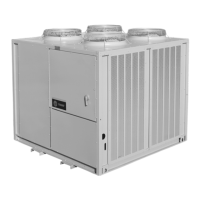68
SS-SVX11K-EN
NNOOTTIICCEE
CCoommppoonneenntt FFaaiilluurree!!
RReessiissttaannccee iinn eexxcceessss ooff 33 oohhmmss ppeerr ccoonndduuccttoorr
ccoouulldd rreessuulltt iinn ccoommppoonneenntt ffaaiilluurree dduuee ttoo
iinnssuuffffiicciieenntt AACC vvoollttaaggee ssuuppppllyy..
DDoo nnoott eexxcceeeedd tthhrreeee ((33)) oohhmmss ppeerr ccoonndduuccttoorr ffoorr
tthhee lleennggtthh ooff tthhee rruunn..
Before installing any connecting wiring, see drawings
in the Dimensions and Weights chapter for the
electrical access locations provided on the unit and
table below for AC conductor sizing guidelines, and;
• Use copper conductors unless otherwise specified.
• Ensure that the AC control wiring between the
controls and the unit’s termination point does not
exceed three (3) ohms/conductor for the length of
the run.
• Be sure to check all loads and conductors for
grounds, shorts, and miswires.
• Do not run the AC low voltage wiring in the same
conduit with the high voltage power wiring.
Typical Low voltage components may include:
• Zone thermostat wiring (AC & DC wiring)
• System control switch wiring (VAV units)
• Night setback relay wiring (VAV units)
• Economizer actuator circuit wiring (VAV units)
• Discharge air sensor wiring (VAV units)
• Jumpers for hot gas bypass operation
• Chilled water temperature sensor (EVP units)
Table 22. AC conductors
Distance from Unit to Control
Recommended
Wire Size
000 - 460 feet
18 gauge
461 - 732 feet
16 gauge
733 - 1000 feet
14 gauge
Controls — DC Analog Input/Outputs
WWAARRNNIINNGG
HHaazzaarrddoouuss VVoollttaaggee!!
FFaaiilluurree ttoo ddiissccoonnnneecctt ppoowweerr bbeeffoorree sseerrvviicciinngg ccoouulldd
rreessuulltt iinn ddeeaatthh oorr sseerriioouuss iinnjjuurryy..
DDiissccoonnnneecctt aallll eelleeccttrriicc ppoowweerr,, iinncclluuddiinngg rreemmoottee
ddiissccoonnnneeccttss bbeeffoorree sseerrvviicciinngg.. FFoollllooww pprrooppeerr
lloocckkoouutt//ttaaggoouutt pprroocceedduurreess ttoo eennssuurree tthhee ppoowweerr
ccaann nnoott bbee iinnaaddvveerrtteennttllyy eenneerrggiizzeedd.. VVeerriiffyy tthhaatt nnoo
ppoowweerr iiss pprreesseenntt wwiitthh aa vvoollttmmeetteerr..
Before installing any connecting wiring between the
unit and components utilizing a DC analog input/
output, see drawings in Dimensions and Weights
chapter for the electrical access locations provided on
the unit.
Table 23. Components
Unit Size
(tons)
Component
(a)
Designation Unit
Type
20 to 60 Field installed
Discharge Duct
Sensor
6RT1 CV
Field installed
Return Duct Sensor
6RT6 CV
Field installed
Discharge Air
Sensor
6RT3 VAV
Field installed
Chilled Water
Sensor
6RT2 EVP
80 to 120 Field installed
Discharge Air
Sensor
8RT3 VAV
Field installed
Chilled Water
Sensor
8RT2 EVP
(a)
Units may include the listed components. Not all components will be
selected on all units.
• Wiring for the components utilizing a DC analog
input/output signal must be shielded cable (Belden
8760 or equivalent). Ground the shield at one end
only.
• Table below lists the conductor sizing guidelines
that must be followed when interconnecting a DC
binary output device to the unit.
NNoottee:: Resistance in excess of 2.5 ohms per
conductor can cause deviations in the
accuracy of the controls.
• Ensure that the wiring between the binary controls
and the unit’s termination point does not exceed
two and a half (2.5) ohms/conductor for the length
of the run.
• Do not run the electrical wires transporting DC
signals in or around conduit housing high voltage
wires.
Table 24. DC conductors
Distance from Unit to Control
Recommended
Wire Size
000 - 499 feet
16 gauge
500 - 1000 feet
14 gauge
Economizer Actuator Circuit
Each unit ordered with the Constant Volume or
Variable Air Volume control option has the capability of
controlling a field installed economizer. The diagram
below illustrates a typical economizer actuator circuit.
When connecting the economizer actuator control
circuit to the terminal board inside the unit control
IInnssttaallllaattiioonn EElleeccttrriiccaall

